Since 16 March, a lot has changed in Naumburg Cathedral. Our World Heritage Site had to remain closed until 8 May to counteract the rapid spread of the Corona pandemic. Events, guided tours and museum educational offers cannot take place until further notice. So that you do not have to miss out on new insights into our world heritage at home, we provide here the various topics for you to digitally discover Naumburg Cathedral: We show virtual tours, works of art under the magnifying glass, we provide offers for young explorers and time travel to the Middle Ages. Drop by every now and then!
Virtual tours
Visit to the Chapel of St Giles for the Romanesque Opening Day
Every Saturday after Ascension Day, the buildings of the "Romanesque Route" invite you to special visits on the Romanesque Opening Day. This year, we wanted to show you an extraordinary treasure on the "Romanesque Route": the Chapel of St Giles on the north side of Naumburg Cathedral. Instead, come along on a virtual tour.

The stone chapel, which was named after St Giles, is one of several chapels originally provided for the private use of the cathedral’s canons. It dates back to the early 13th century, more or less coinciding with the start of construction of the second, late-Romanesque Naumburg Cathedral. Its clear Romanesque architectural style with its perfectly symmetrical round arches is still impressive today.
Of particular note is the Romanesque tympanum, parts of which still survive, with a depiction of the legend of St Giles. It is said that Giles lived as a hermit in France in the 7th century. By God's guidance, he was fed milk from a hind. When the king was hunting, the hind fled to Giles. He protected the animal and was hit by the king's arrow instead. Giles survived, but the wound would not heal until the end of his life. The king was very sad and had a monastery built to forgive his guilt, which he named after Giles. In iconography, therefore, Giles is often depicted with a hind.
Virtually through Naumburg Cathedral
Did you know that our world heritage can also be visited online? Our cathedral is available as a 360° online experience. Welcome to the digital cathedral:

Virtually through Merseburg Cathedral
Why not discover the other sites of Vereinigte Domstifter? Come with us on a short digital tour of Merseburg Cathedral.
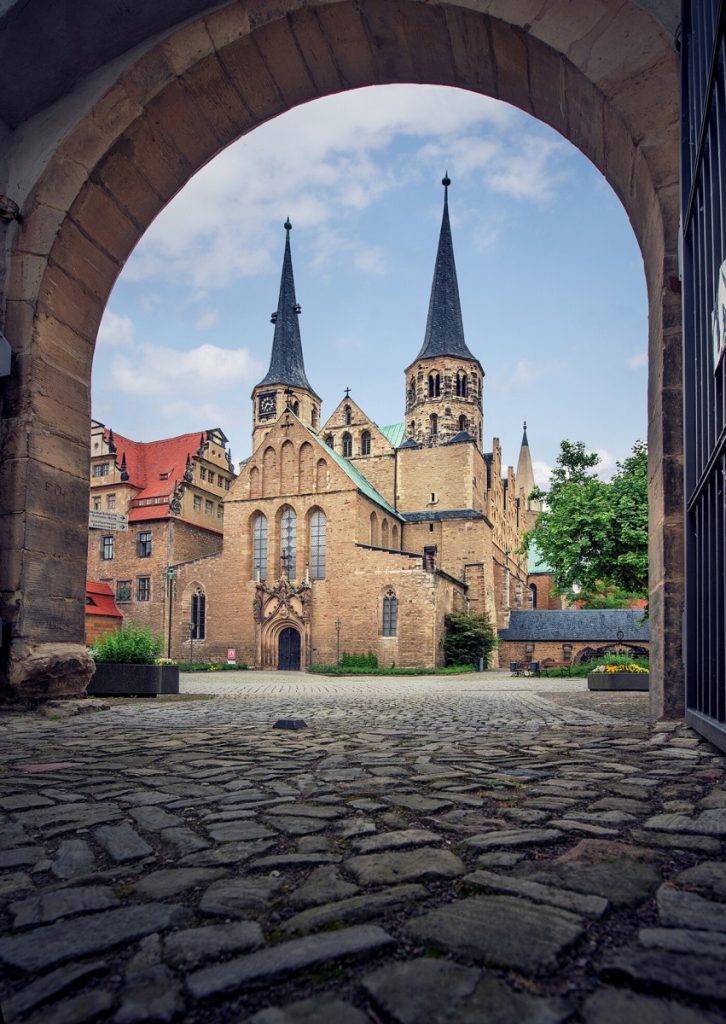
Merseburg Cathedral 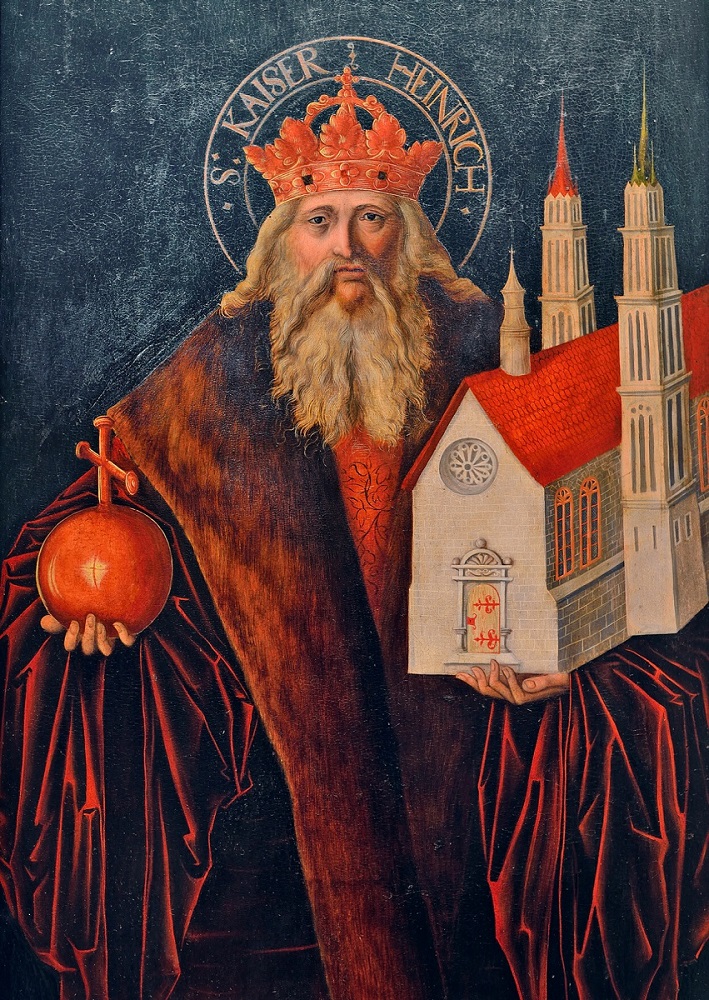
Henry's altar. Lucas Cranach the Elder (1535/1537) 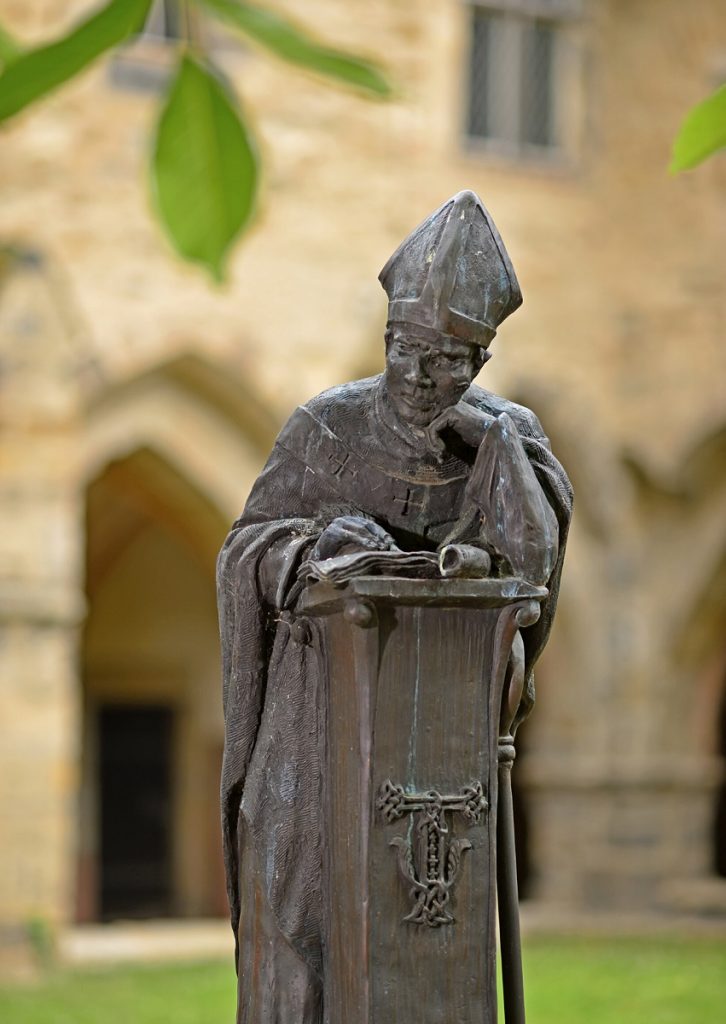
Thietmar Fountain 
Tomb slab of Rudolf von Rheinfelden 
Ladegast organ 
Chapter House Garden
Picture 1: Welcome to Merseburg Cathedral, a favourite place of German emperors and kings. It is an impressive testimony of 1000 years of German history. Whether Otto the Great or Emperor Heinrich II, Bishop Thietmar or Rudolf von Rheinfelden - they are all closely connected with the history of the cathedral.
Picture 2: In the year 955 Otto the Great (912-973) made a vow in the decisive battle on the Lechfeld during the victory over the Hungarians: He wanted to found a diocese in Merseburg. In 968 he kept his promise. However, the Merseburg diocese was soon dissolved and finally refounded in 1004 by Henry II (973-1024). Henry laid the foundation stone for the construction of the present cathedral. In many depictions, such as the Henry altar by Lucas Cranach the Elder (1535/1537) shown here, Henry is therefore depicted together with the cathedral.
Picture 3: Bishop Thietmar von Merseburg (975-1018) is one of the most important chroniclers of the Ottonian age. You can meet him in the cloister at the Thietmar Fountain. The Bishop of Merseburg, who reigned from 1009 to 1018, made Merseburg famous beyond all national borders in his unique chronicle.
Picture 4: A really adventurous chapter of Merseburg Cathedral is the fight of the counter king Rudolf von Rheinfelden (1025-1080) against King Henry IV. Rudolf von Rheinfelden was supported by the Saxon princes. In the decisive battle of Hohenmölsen the counter-king was able to achieve victory over Henry, but his right hand was cut off in the battle. He died of the consequences of the injury. His gravestone can be seen in the centre of Merseburg Cathedral, a demonstration which was clearly political at the time. A mummified hand in the cathedral treasure is also attributed to him.
Picture 5: In the cathedral, not only the historical events of the Middle Ages can be discovered. The Ladegast organ is a magnificent testimony to the baroque era. At that time the cathedral was used as the court church of the ducal family of Saxony-Merseburg, a collateral line of the Wettin family. They were responsible for the construction of a new organ. In the 19th century the organ was rebuilt by Friedrich Ladegast, but the organ facade was retained. The new organ opened a new chapter in the art of organ building and helped the builder Ladegast to great fame.
Picture 6: Finally, we go out once more into the cozy Chapter House Garden. The terraced garden is designed according to the baroque model and is a true oasis. Although it is not yet as green as in the picture, we are looking forward to the blooming and fragrant seasons, when our guests can visit the garden again in real life.
Virtually through the Chapter Library in Zeitz
And of course there is also a lot to discover in the Chapter Library in Zeitz. Here we present you some selected book treasures and of course the unique Zeitz world map.

Julius Plough 
Publius Terentius Afer: Comico Carmine. Strasbourg, J. Grüninger 15 April 1503. 
Guillaume Rondelet: De piscibus marinis libri XVIII. Lyon: Macé Bonhomme, 1554 
Hernán Cortés: Proeclara Ferdinandi Cortesii de Nova Maris Oceani Hyspania Narratio. Nuremberg, Friedrich Peypus, 1. March 1524 
Mappa mundi Cicensis, 1470
Picture 1: Julius Pflug (1499-1564) welcomes all guests in the Chapter Library. His private library is the most impressive part of the Zeitz Chapter Library. Julius Pflug, the last Catholic bishop of Naumburg, collected the knowledge of his time in his library, an exciting and almost completely preserved treasure that reflects the world knowledge of the Reformation period.
Picture 2: Julius Pflug's library contains true literary classics such as the six comedies by Publius Terentius Afer (died ca. 185/158 B.C.), the most important comedy writer of Roman antiquity. The plays were rediscovered in the Renaissance. Terence, as he is called in English, is also considered the most important source of the Latin colloquial language. How, when and where Pflug acquired this print is unknown. The texts are illustrated with wood prints. On one page Pflug obviously shows himself as an artist and decorated the page with his own "artwork".
Picture 3: Pflug obviously also showed a high level of interest in natural science. Among other things, the work "De piscibus marinis" by the French natural scientist Guillaune Rondelet (1507-1566) bears witness to this. In 1554, he published a book on marine life. In it, he made no distinction between fish, seals, whales and invertebrates. The richly illustrated book bears a note of ownership by the bishop (IEN = Iulius Episcopus Naumburgensis) with the date 1561.
Picture 4: The lifetime of Julius Pflug was not only marked by the Reformation, but all over the world there were tremendous upheavals. Thus in Pflug's library there are also writings of the Spanish conqueror Hernán Cortés (1485-1547), who conquered the empire of the Aztecs in 1519/21. His letters to Charles V are among the first official reports on Central America and its peoples, on Moctezuma and the Aztec Empire. It is also a justification of Cortés for the bloody conquest of the "New World", which was to result in an almost complete extermination of the Aztec people.
Picture 5: Finally we show our most precious treasure: the Zeitz world map. It represents the medieval world view in a unique way, probably 20 years before the European discovery of America. Such a medieval map is absolutely unique in Germany. Especially the Mediterranean area already corresponds very much to our cartographic knowledge of today. But the further we move away from the Mediterranean, the more indistinct the surveying of the world becomes. The centre of the map is Jerusalem. But the map does not only contain geographical knowledge: Also legends and (dubious) traditions from the most distant countries have been immortalized on the map. For example, we learn where the island of the bearded women is located. And that in India there are giant ants guarding mountains of gold. By the way, in this picture the map is upside down, so that it can be understood better, because actually on the map above is the south and below is the north.
Works of art under the magnifying glass
Naumburg Pietà
One of the most extraordinary treasures in the Naumburg Cathedral Treasury Vault is the Naumburg Pietà, which was built around 1330. The picture type of the Pietà was created in the early 14th century and shows Mary as Mother of Sorrows with the dead Jesus on her lap. It is a devotional picture that focuses on the suffering of Christ on the cross as well as the compassion of the mother. The Naumburg Pietà is one of the oldest works of this type of painting.

The Pietà is also known as the image of Vespers, because according to Christian belief, the body of Jesus was given to his mother at evening time. The Vespers image is therefore originally included in the evening prayers of the Hours. In Naumburg, too, the Pietà could have been part of the Vespers altar. This was located in the immediate vicinity of the main portal of the cathedral.
The Naumburg Pietà touches with its extraordinary expressiveness. Pain dominates the scene, Mary holds the emaciated body of her dead son almost in an upright position, so that the wounds of the body are brought before the viewer's eyes. But her face connects quite contradictory feelings. Her weeping eyes show the anguish of a grieving mother, but her smiling mouth shows the sublime knowledge of Christ's resurrection and the redemption of mankind.

Cathedral treasure in need - the Kistritz altar
In our Cathedral Treasury Vault there is a Holy Helper for all situations in life: The Kistritz altar was originally created for the Stephanus Chapel on the ground floor of the southeast tower. An enigmatic master with the abbreviation HW made the artistic altar in 1510.
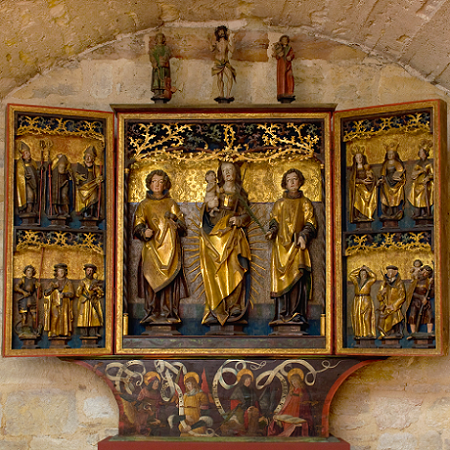
Next to the Madonna on a Crescent Moon in the aureole with the Child Jesus in the middle of the altar, you can distinguish the Fourteen Holy Helpers, who are in the four registers of the altar and at the top of the shrine box. The cult of the Holy Helpers spread in Late Middle Ages over large parts of Europe. Also in Naumburg, the saints were called on as patron saint in prayers to provide assistance in cases of illness or serious crisis. In most cases, the diseases and complaints had a connection to the martyrdom of the individual saint.
For example, in the upper left corner we see the three bishops: Blaise, Denis and Nicholas. Saint Denis was beheaded on the Martyrs' Hill near Paris (Montmartre) and therefore carries his head in front of him. The decapitated man was supposed to help with headaches, among other things. Below the bishops are the three knightly saints George, Sebastian and Eustachius. Saint George (known as the dragon slayer) is represented here with a dragon. He was invoked in times of general need in wars, famines and epidemics such as the plague.
On the upper right are the female Holy Helpers, the virgins Barbara, Margaret and Catherine. Margaret, for example, is the patron saint of those who give birth. Below them are the martyrs Pantaleon, Giles and Christopher. St. Christopher is often depicted as a giant carrying Jesus across a river. He is the patron saint of travellers, but also helps with toothache and bad dreams. The last two Holy Helpers, Vitus and Cyriacus, stand above the central part, to the left and right of Christ.
Passion relief of the West Choir Screen
We want to have a close look at one of the most outstanding art treasures of our World Heritage Site: the West Choir Screen with its Passion reliefs, created by the Naumburg Master. To retell the story of the Passion, he worked out seven impressive scenes, each from a single block of limestone. The figures surprise and touch through their vividness and high emotionality.

Last Supper 
Thirty pieces of silver
Relief 1: Last Supper
The first relief shows the Last Supper. In this scene Jesus foretells his near death. The Naumburg Master skilfully combines the Gospels of John and Matthew: "It is he to whom I dip and give the bite". (John 13:26) and "He to whom I dip my hand in the dish with me, he shall betray me." (Matthew 26:23). In the Naumburg Master's Last Supper both interpretations are processed. The Naumburg Master even created a third hint to name the traitor among the disciples. Judas sits at the front left, clearly separated from the rest of the group, and causes a meaningful drape in the tablecloth: Like a lot of arrows, the folds point to the left, up to the traitor.
Relief 2: The Thirty Pieces of Silver
The second relief deals with "The Thirty Pieces of Silver" and shows Judas before the high priests. In this scene, the Naumburg Master captures in a unique way the trepidation that grips all figures in the face of betrayal. None of the figures stand upright, whispers are furtively whispered in the background, no one seems to be looking directly at the money transfer. The priest on the far right probably even wants to take his coat and cover the whole scene. Judas himself receives the coins only with his coat, not with his bare hands. Perhaps this is already an indication that he will later return the blood money out of remorse? Also, compared to the others, he does not wear a pointed hat, with which Jews were usually marked in the depictions of the High Middle Ages. All in all he looks more like the tragic hero of the scene.

Arrest of Jesus 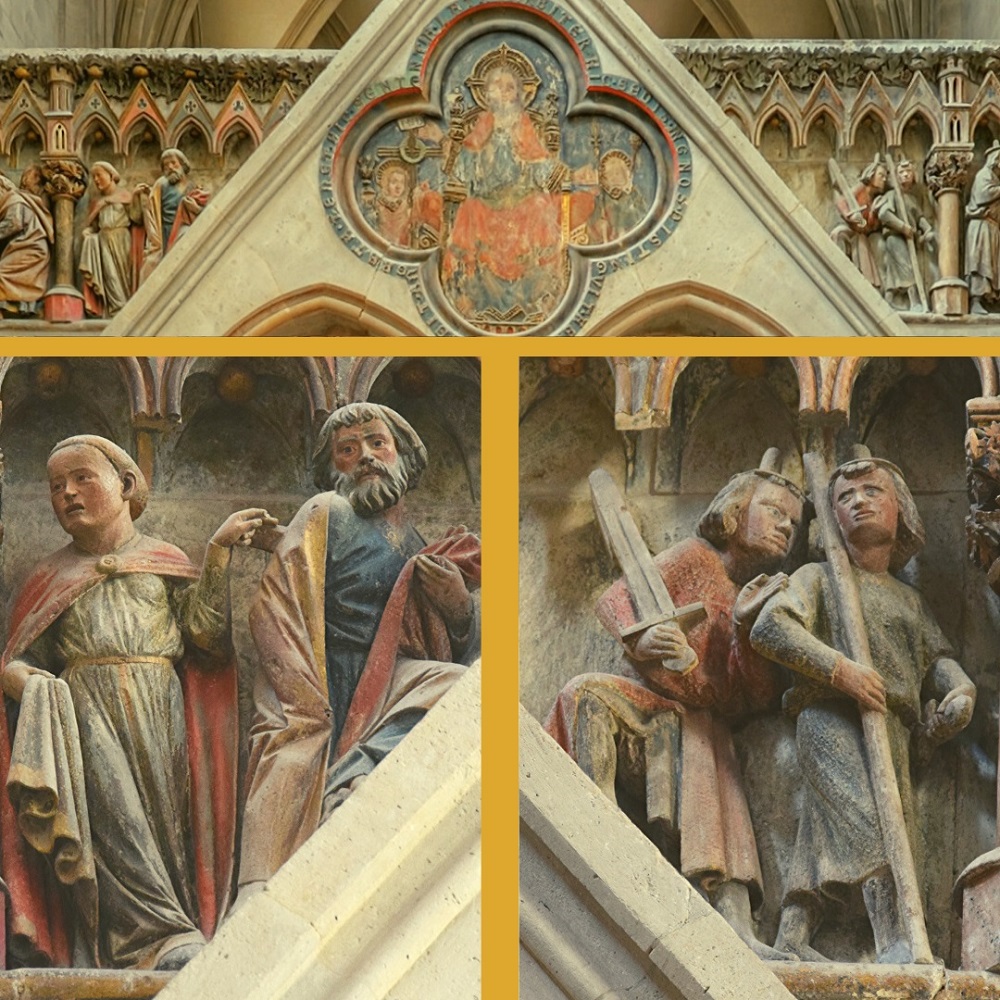
Peter and the maid / The two guards
Relief 3: Capture of Christ
The third relief shows the events of the night after the Last Supper at the foot of the Mount of Olives. Here, in the Garden of Gethsemane, Jesus asked his disciples to pray. But now the servants of the high priest take action and arrest Jesus after Judas has betrayed him with a kiss. The Naumburg Master also immediately processes a second scene: Peter is the only one who tries to resist the capture and cuts off one of the servants' ears with his sword. While the scene seems to be dominated by violence, fear and betrayal, Jesus himself stands calmly in the midst of the many acting people. So he also instructs Peter to lower his sword, "Shall I not drink the cup which my Father has given me?" (John 18:10).
Relief 4: Peter and the maid / The two guards
The fourth relief is particularly striking, because it is actually two small scenes divided by the gable of the West Choir Screen. They depict the denial of Peter, one of the most famous passages in the Bible, and one that has been taken up in art and literature in many ways. Before his arrest, Jesus prophesied to his disciple Peter: "Before the cock crows, you will deny me three times". Peter vehemently denies this, but shortly afterwards his faithfulness is put to the test. The picture on the left side of the pediment shows the first denial of Peter. While Jesus is being questioned, a maid recognizes Peter as one of the disciples, but Peter denies knowing Jesus. The Naumburg Master captures Peter in the middle of the movement. With a gathered cloak he seems to want to flee quickly from the maid over the gable of the choir screen. But on the other side of the pediment there are already two guards. They show the third denial of Peter, because Peter claims not to know Jesus even when facing a guard. The Naumburg Master does not show the second denial. It seems to take place behind the pediment, on the way from one side of the choir screen to the other. After the third denial, a cock actually crowed and Peter remembered the prophecy and wept.

Pilate's trial of Jesus 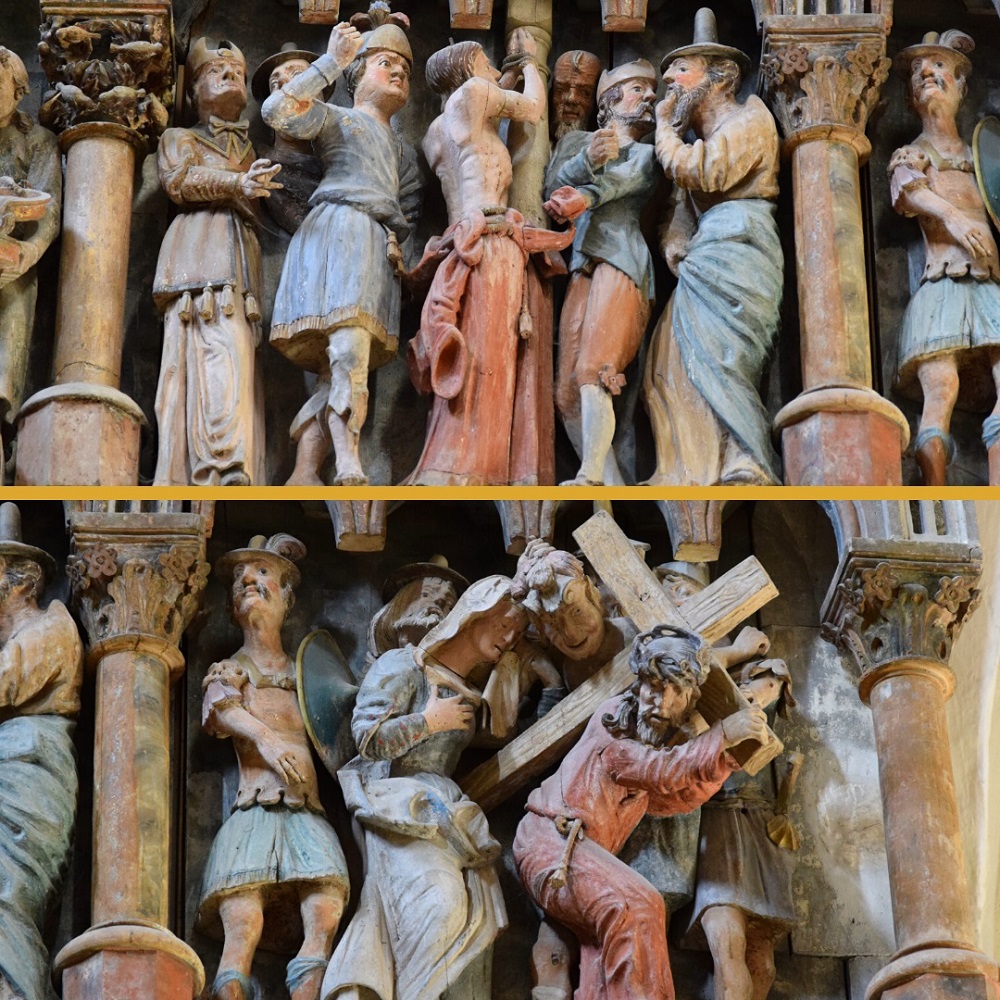
Flagellation of Christ / Carrying of the Cross
Relief 5: Pilate's trial of Jesus
Who washes his hands in such an exemplary manner here? What looks like an allusion to modern times in our fifth Passion relief is actually the Roman governor Pontius Pilate. Jesus is brought before him for questioning. However, Jesus does not plead guilty. His silence is impressively captured by the Naumburg Master. Jesus stands almost enraptured in the left half of the picture, his gaze directed far forward as if he were surrendering to the unchangeable. Pilate seems to find no fault with him, but bows to the pressure of the high priests, who demand a death sentence. But he does not want to see his own responsibility in this. Pilate says: "I am innocent of the blood of this just man; it is your responsibility!" (Matthew 27:24). He places his hands in a bowl of water and symbolically washes them in innocence.
Relief 6 and 7: Flagellation of Christ / Carrying
of the Cross
The last two relief scenes on the West Choir Screen are unfortunately no longer preserved in their original form. They were probably destroyed in a fire in the 16th century. In the middle of the 18th century a master turner from Naumburg replaced them. The reliefs are therefore not - as in the original - made of shell limestone, but of wood. The two scenes "Flagellation of Christ" and "Carrying the Cross" take up the figure compositions of the other scenes, but the clothing of many figures refers to the fashion of the 18th century. The proportions and facial expressions are also far from being as perfectly formed. They do not come close to the vividness and expressiveness of the previous reliefs. Thus the reliefs from the 18th century are without doubt a beautiful woodwork, but in direct comparison they underline even more the high artistry of the Naumburg Master in the 13th century.
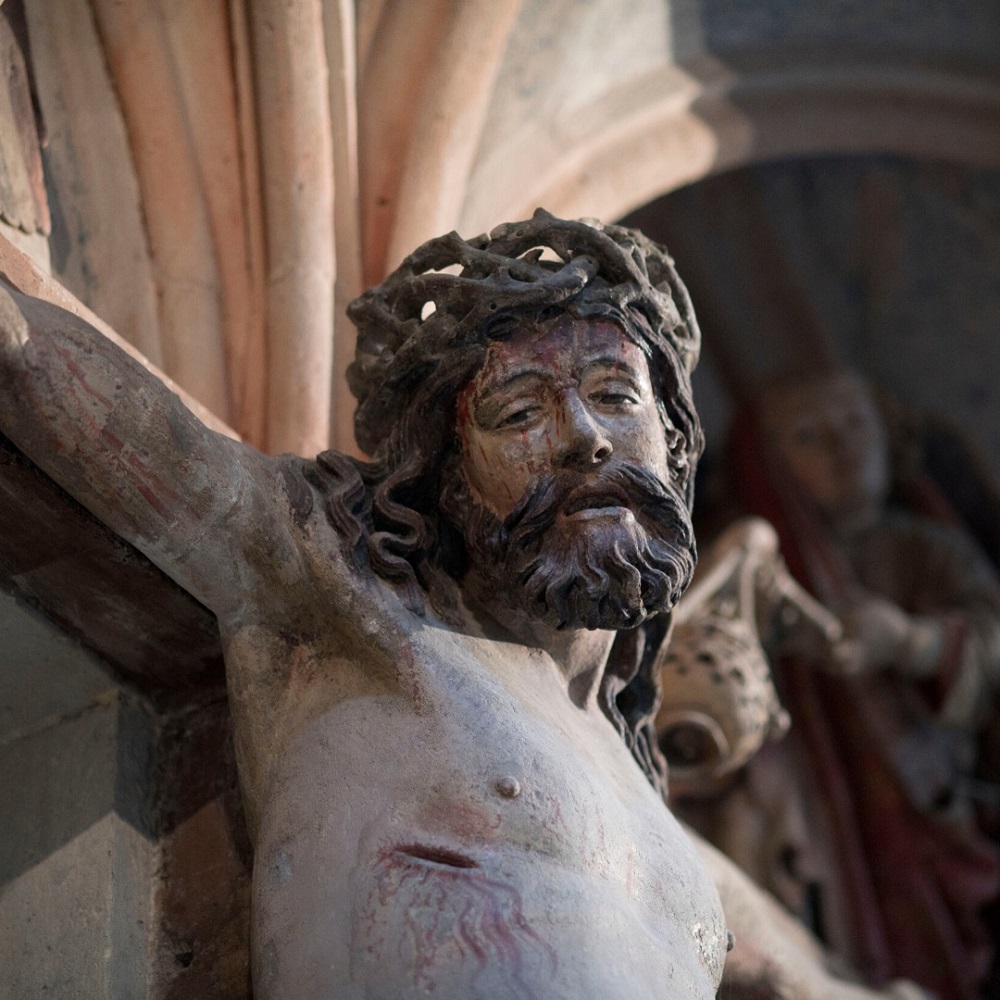
The conclusion and climax of the Passion story on the West Choir Screen is the crucifixion scene. Here the Naumburg Master chose a completely unique representation method for the medieval Gothic style. Christ on the cross is not, as usual, elevated above the choir screen, but almost at the eye level of the viewer directly at the choir screen portal. The sacrificial death of Christ is thus approached in a shocking way. Here, Christ is not an elevated, spatially distant Redeemer. Whoever wants to enter the west choir walks under his arms and is inevitably eye to eye with the sacrificed Son of Man - this must have been a profound religious experience for the people of the 13th century. And even today many of our visitors are still deeply touched when they see the suffering, human Christ.
For young explorers
Podcast tour with the KinderDomBauhütte (in German only)
The team of the KinderDomBauhütte misses it very much to explore our world heritage together with the children. Now Josi, Martin and Jessica have sat down in front of the microphone and recorded a podcast to bring the secrets of the cathedral to the children at home.
Episode 8: The Cathedral Garden

Episode 7: The West Choir

Episode 6: The West Choir Screen
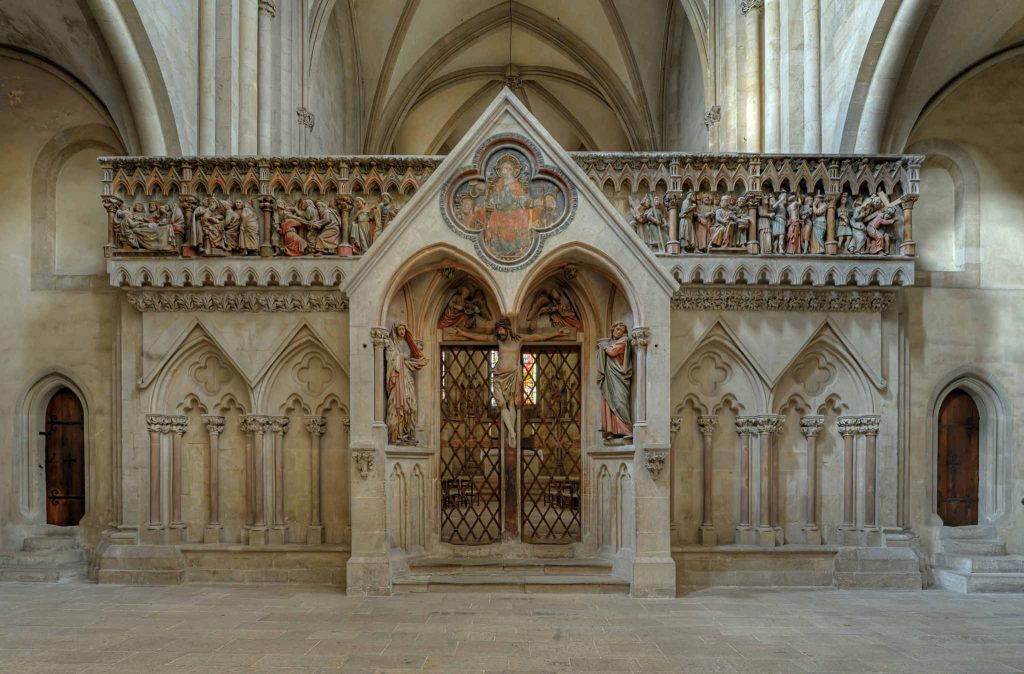
Episode 5: The East Choir Screen and the Nave

Ostlettner 
View from the Ostlettner into the nave
Episode 4: The Narrow Path to Paradise

Episode 3: The East Choir

Episode 2: The Crypt

Episode 1: The Main Entrance

Main portal 
Detail on the capital
A Cathedral animal for home
Naumburg Cathedral is like a zoo, as you can discover numerous animals. Monkeys, birds, sheep, even turtles and salamanders, sometimes made of stone, sometimes of wood, sometimes of bronze. They all inhabit Naumburg Cathedral. As long as the KinderDomBauhütte is closed and they cannot show the animals to the children on site, the KinderDomBauhütte brings the animals to the children's homes. With salt dough and paint, everyone can make their own cathedral animal for home. Off we go on safari!
Here you can download the instructions.
If you want to share your cathedral animal with us, you can post it on Facebook or Instagram with the hashtag #kinderdombauhütte
Naumburg Cathedral for colouring
Our World Heritage Site needs colour and imagination! As long as the KinderDomBauhütte is closed, it sends a little creativity home to the children. Because our Naumburg Cathedral is also available for colouring. You can download and print the template here: here . If you want to share your cathedral picture with us, you can post it on Facebook or Instagram with the hashtag #kinderdombauhütte. We are looking forward to many colourful cathedral pictures!

The play of colours of the Naumburg Master
In our permanent exhibition "Career and Works of the Naumburg Master" you can discover the preparatory work for the impressive play of colours in the West Choir. Two original lead fields from the time between 1243 and 1249 are exhibited here. They include the statue of St. Margaret of Antioch, a window motif in the West Choir of Naumburg Cathedral.

Window in the west choir 
Leadfield
To recreate the intensive play of colours of the windows in the West Choir at home, we provide the lead field as a template for printing. Here children and adults can try out for themselves which colours they would have used for the window of St. Margaret's.
Here you can download the template.
Have fun with the play of colours of the Naumburg Master.
On time travel
We look back: The plague epidemic 1680-1683
When in autumn 1680 a comet with "hideous tails" appeared in the sky, the people of Merseburg, indeed all over Europe, had an evil feeling.

Today we dare a trip to Merseburg - the Merseburg of the 1680s. Here the plague raged for three years. In the records of the Merseburg cathedral chapter from this time we find astonishing details about the handling of the epidemic... and many a measure seems very familiar to us today.
Even during the plague epidemic in the 17th century, people were aware that isolation was an important means of disease control. As early as August 1680, passports were issued to restrict movement and to identify sick people. At that time, people did not yet have passports, but the still young printing technology was used to quickly produce documents for everyone. In each case, space was left for the name to be handwritten. Leipzig and Halle were sealed off for months, so that even in 1681 the subjects of the cathedral chapter were forbidden to attend the Leipzig Easter Fair.
Concrete medical measures were also taken. In 1680 the personal doctor of Duke Christian, Johann Ernst Glaß, was granted the right to run a pharmacy and to produce medicines, including brandy. At no other place in Merseburg was another pharmacy to be opened. This was intended to prevent quacks.
And how were the agreed measures communicated at that time? Today we can follow live press conferences. In the 17th century, resolutions had to be brought to all villages. As early as July 1680, a so-called "patent", an open letter from the sovereign, was drawn up, which contained instructions on how to act during the plague. Such patents were read out and posted in public, mostly at churches or community centres.
From June 1682 Merseburg remained cut off from the outside world for almost a year to prevent further infections. This year, 380 Merseburg residents died of the plague - with an estimated total population of no more than 2500, this was at least 15 percent of the population. In 1683 the cathedral chapter held its chapter meetings in Delitzsch, where the Merseburg chapter government had also fled to.
In March 1684 the danger of epidemics was over: the Cathedral Chapter returned to Merseburg. The income remained low until the 1690s. The Cathedral Chapter made a targeted attempt to encourage the resettlement of its villages by easing the tax burden, in order to be able to operate well again.
The gratitude of the people after survived epidemics has always shown itself in very different ways. The St. Maximi Church in Merseburg, for example, has a so-called plague goblet, a precious vessel that people donated to the church 500 years ago in gratitude for a plague epidemic that was overcome.
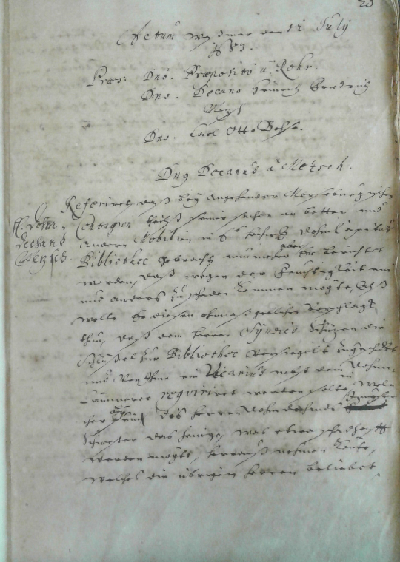
Record of the Cathedral Chapter Meeting 
Plague goblet of Merseburg Town Church
Hidden Texts: A treasure from the Cathedral Chapter Archive
From April to October, on the first Saturday of every month, Matthias Ludwig, the head of the Cathedral Chapter Archive in Naumburg Cathedral, takes you to our archive and library. Because The hidden texts an tell us a lot from almost 1000 years of cathedral history. Now that the special guided tours cannot take place for the time being, we would like to introduce you to a few book treasures in more detail.
Book treasure in May: the Naumburg Hussite tax register of 1426

This special tax register dates from a time when the Central German region was shaken by the Hussite wars. The Hussites go back to the Bohemian theologian and reformer Jan Hus (ca. 1370-1415), who, with his theological controversial writings, questioned the essential claims and structures of the Roman Church and was subsequently burned as a heretic on 6 July 1415 during the Council of Constance. After his death, the Bohemian reform movement radicalized itself, whose followers were called Hussites - in reference to the reformer who was revered as a martyr.

Jan Hus (Portrait of Johann Agricola, 1562) 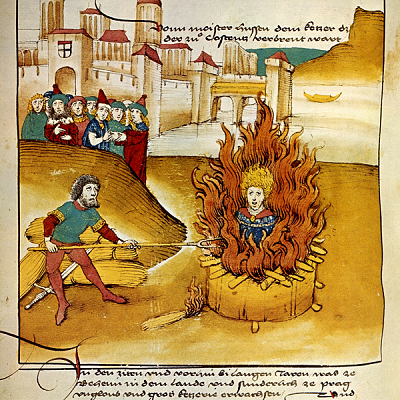
Picture of the Council of Constance from the Spiez Chronicle, 1485
The uprisings and warlike conflicts quickly spread from Bohemia to other areas such as Lusatia, Silesia and Austria. But the Central German area was not spared either. For the diocese of Naumburg the critical phase of the threat was during the reign of Bishop John II v. Schleinitz (1422-1434). Even though the two bishoprics of Naumburg and Zeitz itself were not directly affected by Hussite attacks, there was no way to speak of a safe environment. The bishop therefore decided to impose a so-called Hussite tax in order to prepare for possible attacks.
In the Hussite tax register you can follow these charges exactly. It is a small thin paper booklet entitled Registrum decime episcopalis pro expensis factis contra hussitos seu bohemos anno Domini M°CCCCXXVI (Register of Episcopal Tithes for Expenses against the Hussites or Bohemia in the Year of the Lord 1426). Although it is an unadorned paper manuscript comprising only two leaves, its source value is exceptional, as it is a rare early testimony to the time of the so-called Hussite Wars in the 15th century. It records the valuation of the ecclesiastical fiefs at the churches in the city of Naumburg and contains a total of 80 entries. In doing so, the register provides a unique insight into the ecclesiastical conditions of the town, as all chapels and altars of the main churches in Naumburg are listed here with the value of their earnings.
And what was the money spent on? The phrase "expensis factis" indicates that the relevant expenditure to fight the Hussites had already been made at the time of writing. One can only speculate about how the money was used. However, by dating it to the year 1426, it is possible that the Naumburg bishop used the money to support a war campaign in Bohemia in June 1426.
Book treasure in April: the oath book of the Naumburg Cathedral Chapter from the year 1582

The oath book gives us an amazing insight into the centuries-old traditions of the cathedral chapter. It comprises 62 parchment sheets and was used between 1596 and 1872 to record the oaths of a total of 30 cathedral provosts and deans. It was also an important instrument for the admission of a new canon. In order to take the oath, the canon knelt in front of the book, recited the formula on the left side of the opened oath book and placed two fingers of his oath hand on the image of Christ on the right side.
The upheavals of the Reformation are also reflected in the oath book. Since the late 16th century no Catholic canons have been accepted as a rule. Formally, however, the cathedral chapter remained of mixed confession. Only in the 17th century was the admission procedure formally changed. The text of the oath next to the image of Christ now had to be adapted. Therefore a supplementary sheet was added to the oath book in such a way that the new oath is opposite the image of Christ. With the new oath the canons now also committed themselves to the Augsburg Confession and thus to the Lutheran Church.
The Cathedral Chapter of Vereinigten Domstifter zu Merseburg und Naumburg und des Kollegiatstifts Zeitz still dates back to the spiritual institutions in the 10th century. The canons and canonesses of the 21st century are not only in a traditional, but also legal succession to the canons of the Middle Ages. The oath book, however, is no longer used today.
Devilries in Naumburg and Merseburg Cathedral
The devil shouldn't be in a church - but in some places you meet him anyway. On Walpurgis Night we take a look in our cathedrals where the devil is at work. The devil was immortalised in Naumburg Cathedral by Heinrich Apel: on the handrail "The Narrow Path to Paradise", created in 1983, which leads up the north side to the East Choir.

The path to the Paradise is represented as a snake. At the lower end of the handrail (in hell) the devil rides on the head of the snake that just devoured a sinner. On the body of the snake people try to climb up (to paradise). If you go up the stairs to the East Choir, you can accompany the people on their arduous journey to paradise. The work of art can of course also be used as a handrail: Touching is allowed, finally the touches gradually make the bronze shine. As you can see on the picture, our vsitors already liked to touch the head of the snake or the devil's nose and horns.
The legend of the devil's claws in Merseburg Cathedral
In Merseburg Cathedral the devil was much more active. On the columns of the cloister we find even miraculous grooves, which are said to have been caused by the devil himself.
In the Middle Ages a master builder was commissioned to create the cloister for Merseburg Cathedral. But none of his construction plans satisfied him and in his desperation he called the devil to help. The devil was willing to create the cloister, but demanded the master builder's soul as payment. He agreed, but made one condition: "The cloister should be completely perfect, so our contract is valid". The Devil had the cloister built in just one night, but he hadn't counted on the master builder's prudence. For the following day he had the cloister consecrated and then checked together with the devil whether the cloister was also completely perfect. In the western chapel he found out that the devil had probably not succeeded in erecting an altar with the image of the crucified Saviour. The contract was not fulfilled. The devil became so angry that he tried, as it were, to demolish the cloister again. But his claws caused only scratch marks, small grooves, in the masonry of the consecrated stone. These claw marks can still be seen today. And because the devil did not succeed, he finally drove into the walls out of rage. Thus, in addition to the grooves, the figure of a small devil can also be discovered in a corner of the cloister.

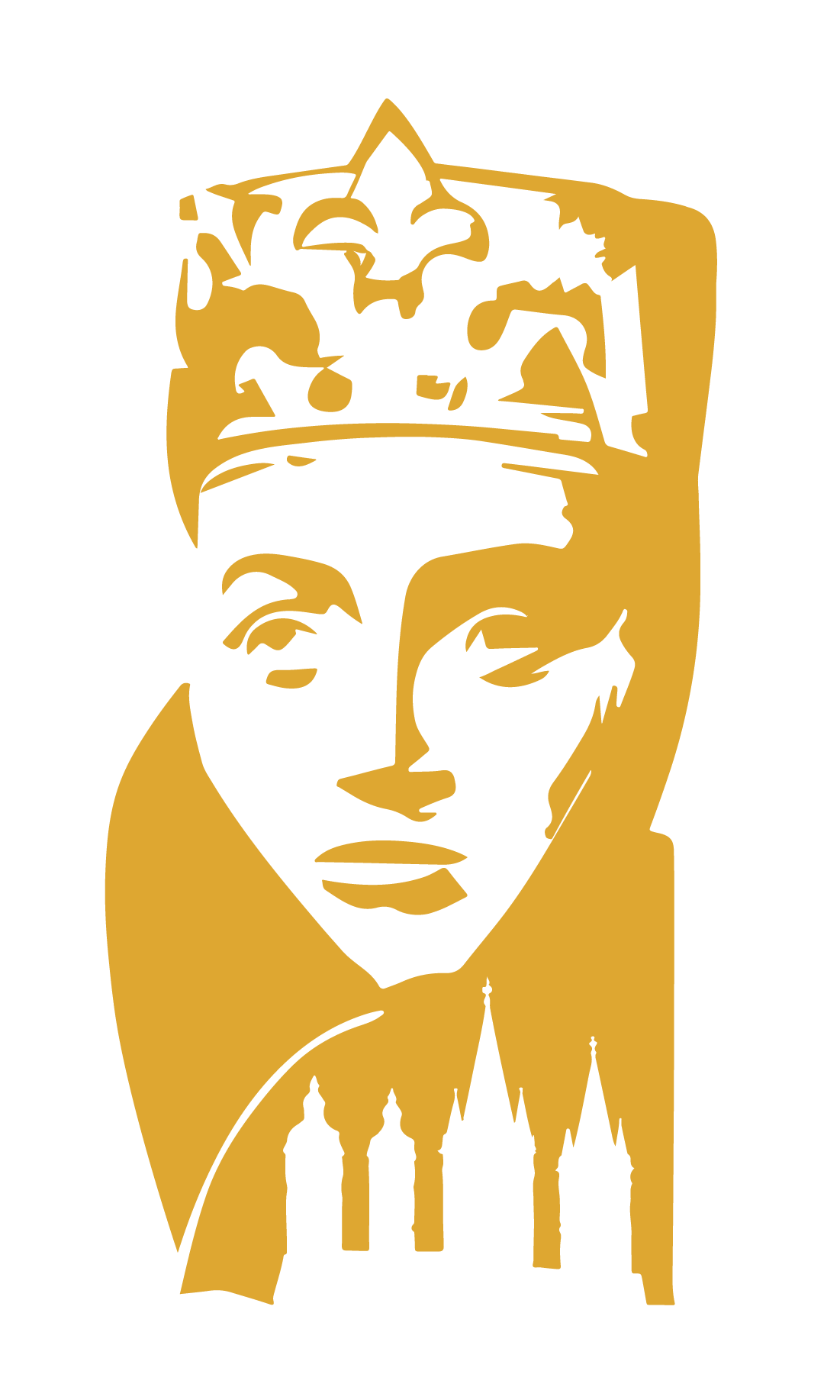

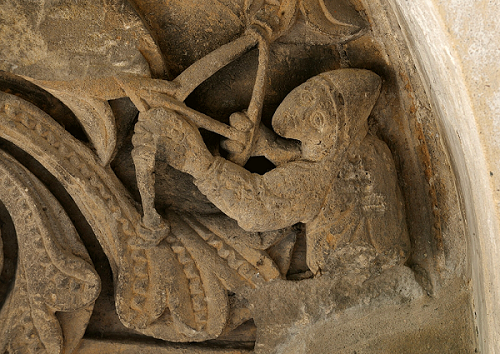





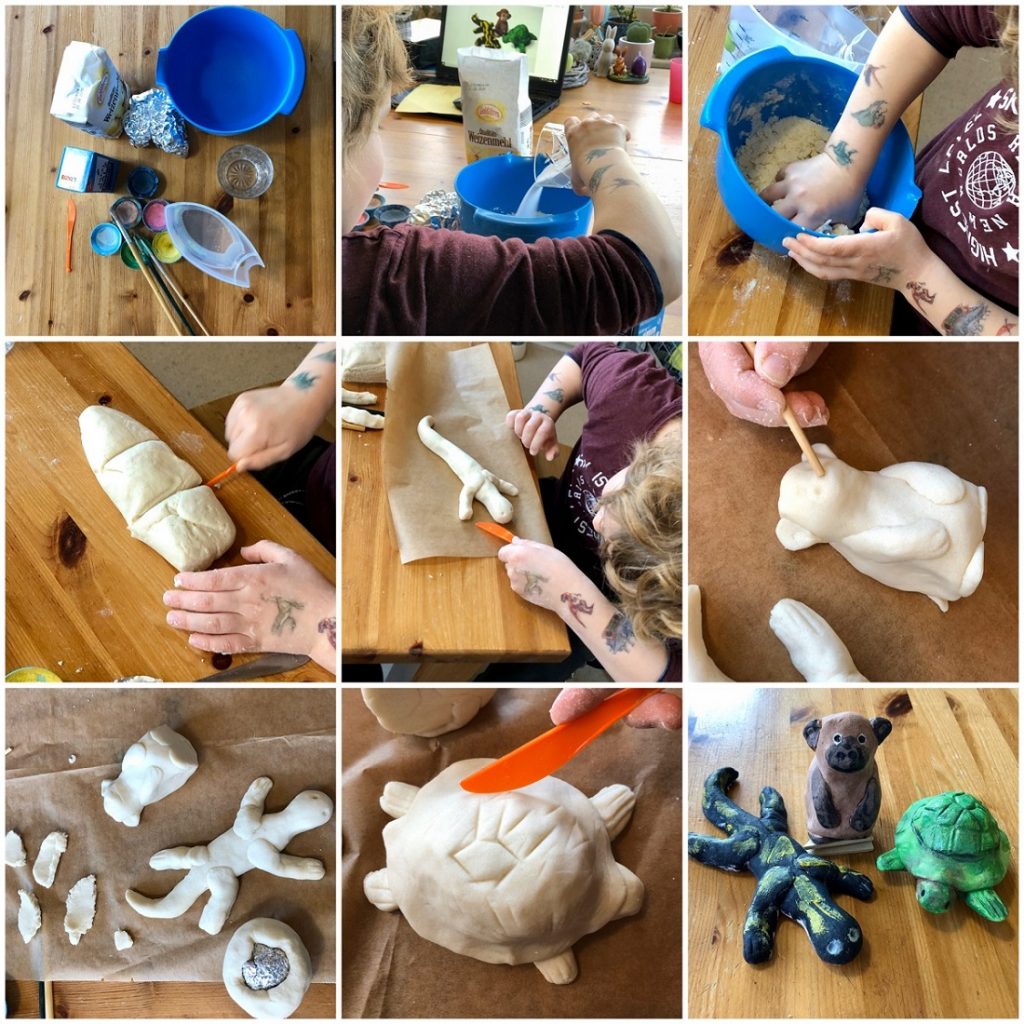



 Skip to content
Skip to content